This story starts long before the bird in question was found. The coast at Kilcoole, Co Wicklow, has been my birding 'patch' since I was a kid, with regular trips made there alongside my father, Noel Keogh, since the mid-1990s, followed by solo excursions in my teens during the 2000s where I got a handle on identification, counting and the joy of finding a few scarce and rare species.
A regular fixture of these formative years was helping out at the Kilcoole Little Tern conservation project run by BirdWatch Ireland and the National Parks & Wildlife Service. This led the way to my first job in conservation in 2010 when I started as a full-time warden there while fresh out of an undergraduate degree, and continued in this role for four seasons. Keen on rarities, it was obvious that spending time at a Little Tern colony like this could be the chance to find a Least Tern, a species I was aware of on account of the record of a bird present at Rye Harbour from 1983-1992, known as 'Squeaker' due to its calls which were said to be of a similar tone to Eurasian Oystercatcher.
During my time with the Kilcoole Little Terns I became accustomed with their various calls, but nothing ever jumped out at me as being different or 'squeaky'. I also kept an eye on rump colouration and only ever came across a single bird with a limited, light grey wash to the rump and uppertail coverts (likely a female based on behaviour). A visit to the colony at Cahore, Co Wexford, in July 2012 provided a tantalising view of a grey-rumped second-calendar-year bird in flight, but I was aware that grey rumps are known from Little Tern in non-breeding and immature plumages. As the years went on, survey visits to most of Ireland's main Little Tern colonies revealed no Least candidates and the promise of finding one faded, but the idea was kept 'on file' in the back of my mind. A visit to the Outer Banks in North Carolina during 2017 provided me with my first looks at Least Terns and I was impressed by their solid-looking, 'stormy grey' upperparts and how different the calls were from Little Tern (and unlike oystercatchers!).
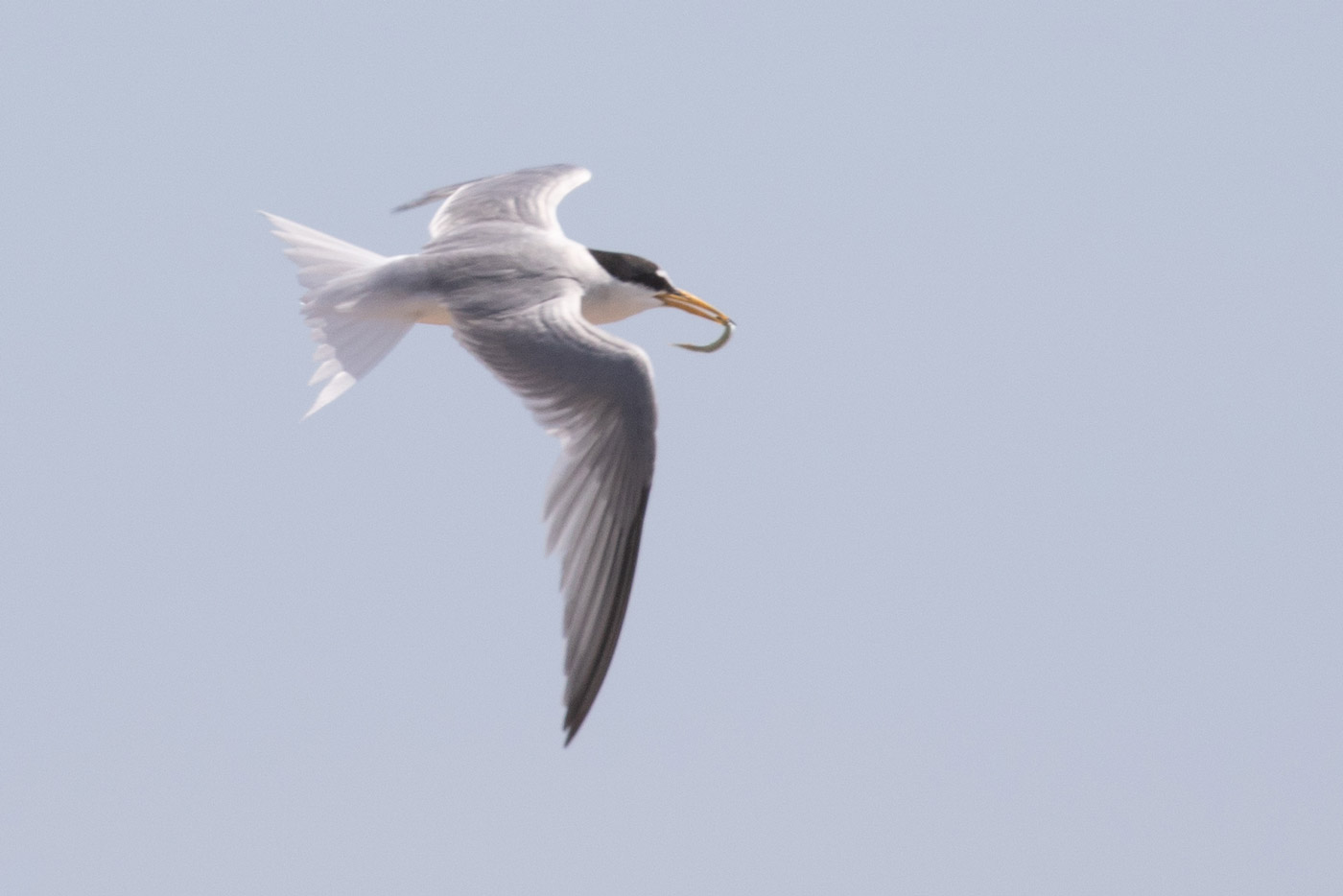
A Little Tern showing a faint grey wash to the rump at Portrane, Co Dublin, on 25 July 2021 (Paul Lynch).
Little Terns were back on the agenda for me in summer 2021 with renewed visits to Kilcoole (after a Covid-induced hiatus in 2020) and surveying around sites in north Dublin where a small colony is found at Portrane (and increasing thanks to the efforts of volunteers and local BirdWatch Ireland members with support from Fingal County Council and National Parks & Wildlife Service). In mid-June I was fortunate to tag along with BirdWatch Ireland staff for some colour-ringing of adult Little Terns at Kilcoole and took the opportunity to look at rump and tail colouration in the hand. I jokingly said I was "looking for a Least" with some birding pals at the time and follow up chat about the prospects of finding one in Ireland led to me digging out the write up in British Birds by Barry Yates about the Rye Harbour bird for a look-over.
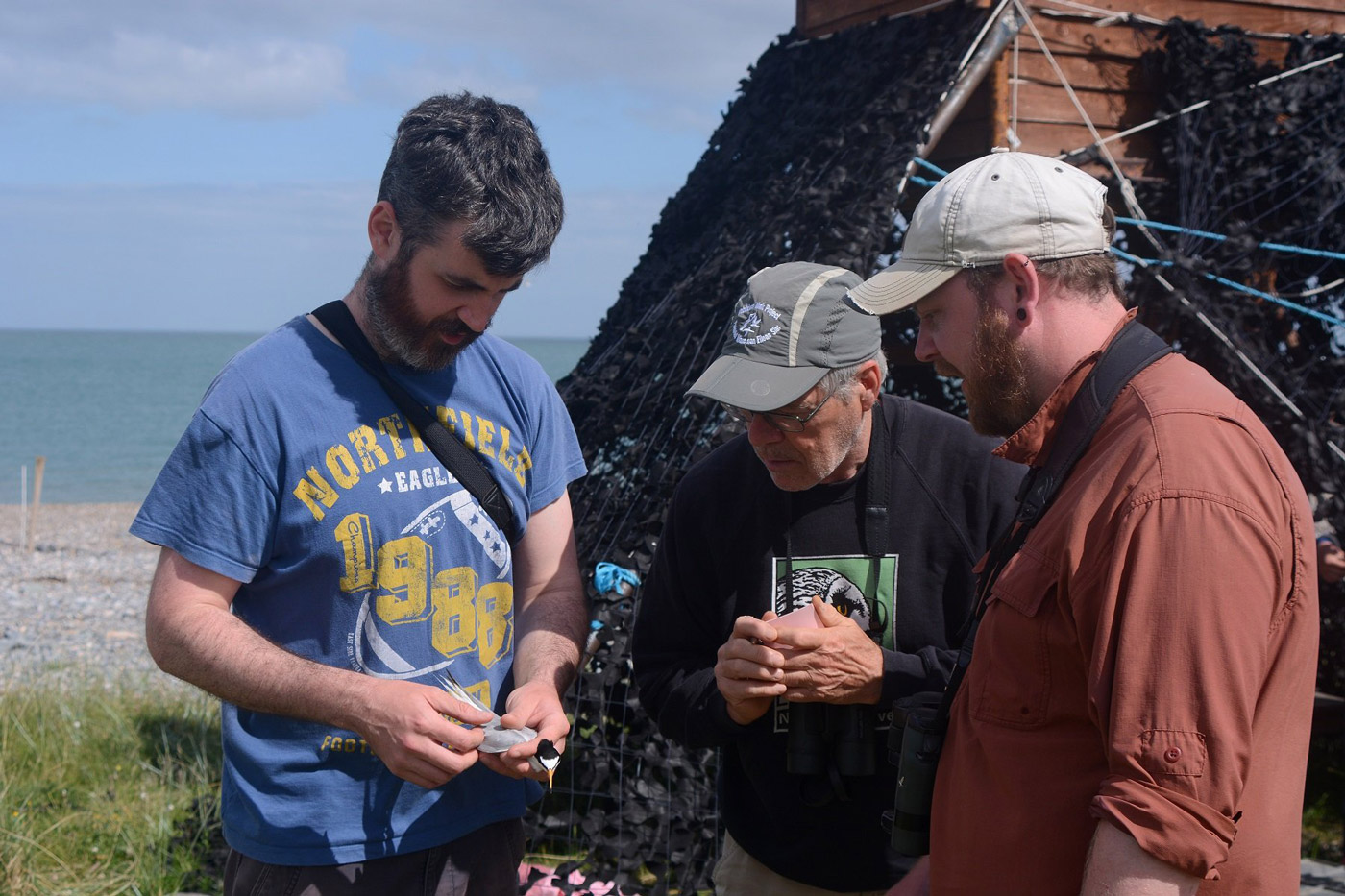
Colour-ringing Little Terns at Kilcoole, Co Wicklow, 11 June 2021. Left to right: Brian Burke, Dr Steve Newton and Niall Keogh (Andrew Power).
Just over a week later on 19 June, I was at Rogerstown Estuary in north Dublin with Noel. We have spent a bit more time birding there this year (a site we previously only visited in winter) and were enjoying the early build-up of returning and non-breeding waders, looking through flocks of Grey Plover and godwits with species such as Great Knot on the brain. At about 8.15 am while checking the inner estuary from Frank McManus Hide, I scanned with the scope towards the outer estuary and noticed two Little Terns approaching from the east. As these were the first I have seen at this site I had a quick look at them while they were approaching and then returned to looking through the flock of roosting waders across from the hide. While my head was buried in the scope the terns must have flown past right in front of myself and Noel and it was at this point I heard an unusual, loud and 'squeaky' call. Initially I thought it might have come from a wader so had a quick look around but then realised that it likely came from one of the 'Little' Terns that flew past.
Alarm bells rang so I trained my scope on the terns, which were now about 500 m up the estuary to our west. At this point I realised that three birds were present (seemingly two males chasing a female) and that one of the males lacked the obvious contrast between the grey back and white rump/tail that was apparent on the two Little Terns accompanying it even at that range. I quickly informed Noel to get on the bird and I whipped out my smartphone and switched on the Voice Record Pro app knowing that if my suspicions were true, then a sound recording would be key to confirming the identification.
The terns soon started heading back east towards us and we kept track of the grey-rumped male in our scopes. Very little was said between us at this stage. "Get on this Little Tern with a grey rump" was enough to imply the severity of the situation and that was followed up with "I've got my sound recording app running so be quiet". Short and to the point. This wasn't going to be an easy identification and it was all about focus and getting the details now. I could feel my heart starting to beat a little louder in my chest.
Then, just as the three terns flew past us (at a range of c 100 m) the bird in question let out a series of almost Ring-necked Parakeet-like calls! The loud, explosive and squeaky nature of the calls were like nothing I've ever heard from Little Tern. Once I was happy that a recording of the call was obtained, we both had a brief (and excited) exchange about how distinctive the call was and I suggested to Noel that we now focus on details of the rump, uppertail coverts and tail. The bird was too far away to attempt any kind of effective phonescoping but as it headed east and away from us it began fishing and diving, allowing for good (if distant) views of the rump and tail as the bird stalled in the air, spread the tail and dived. The light was good, clear and flat during this time and on all occasions when the bird banked or plunge dived, the continuous, uniform nature to the grey wings, back, rump and central tail region right out to the tip was apparent, with the longer outer tail feathers being the only area that looked white, and contrastingly so. This feature held true even at 500-600 m range, during side-by-side comparisons with the two Little Terns which showed the obvious sharp contrast between the grey back and white rump and tail.
Initial sound recording made by phone at Rogerstown Estuary south hide on 19 June 2021 (Niall Keogh).
I knew there and then that these calls, along with the grey rump and tail, indicated strongly that the bird must be a Least Tern. I sent a message with a brief description of the bird plus the sound recording to Killian Mullarney, who got back to me quickly and confirmed my suspicions. We had the bird in view for probably a maximum of 10 minutes and it was last seen heading east towards the outer estuary. It was obvious that it would end up at the nearby Little Tern colony at Portrane, so as we raced back to the car I made a couple of phone calls to the wardens there so we could try relocate the bird and also discuss access for visiting birders. Not long after we arrived at the colony site, we picked up the Least Tern and discussions with the wardening team revealed that a 'squeaky'-sounding tern had been noted there within the previous two weeks and also in 2020 (with subsequent checking of photos from last year revealing a tern photographed there that looks like the bird). Shades of the Rye Harbour story.
Recordings of the Least Tern made at the Portrane Little Tern colony on 27 June 2021 (Paul Lynch).
I was happy that the bird wasn't going to go anywhere in a hurry, so we took the time to put together a plan for those coming to see it, sussing out best viewing locations and parking spots. As a former warden myself I wanted to get this right and make sure all was above board. Once the Little Tern team on site was content with the arrangements, I was able to put the news out. I breathed a huge sigh of relief and was able to relax for the first time in a couple of hours! Folk started arriving soon after and we were able to enjoy nice views of the tern out on the strand throughout the afternoon. A first for Ireland and second for the Western Palearctic twitch on a weekend near the capital city resulted in about 50 birders making it on site for the tern by that evening. This is something I really enjoy about birding in Ireland, the lack of large crowds!
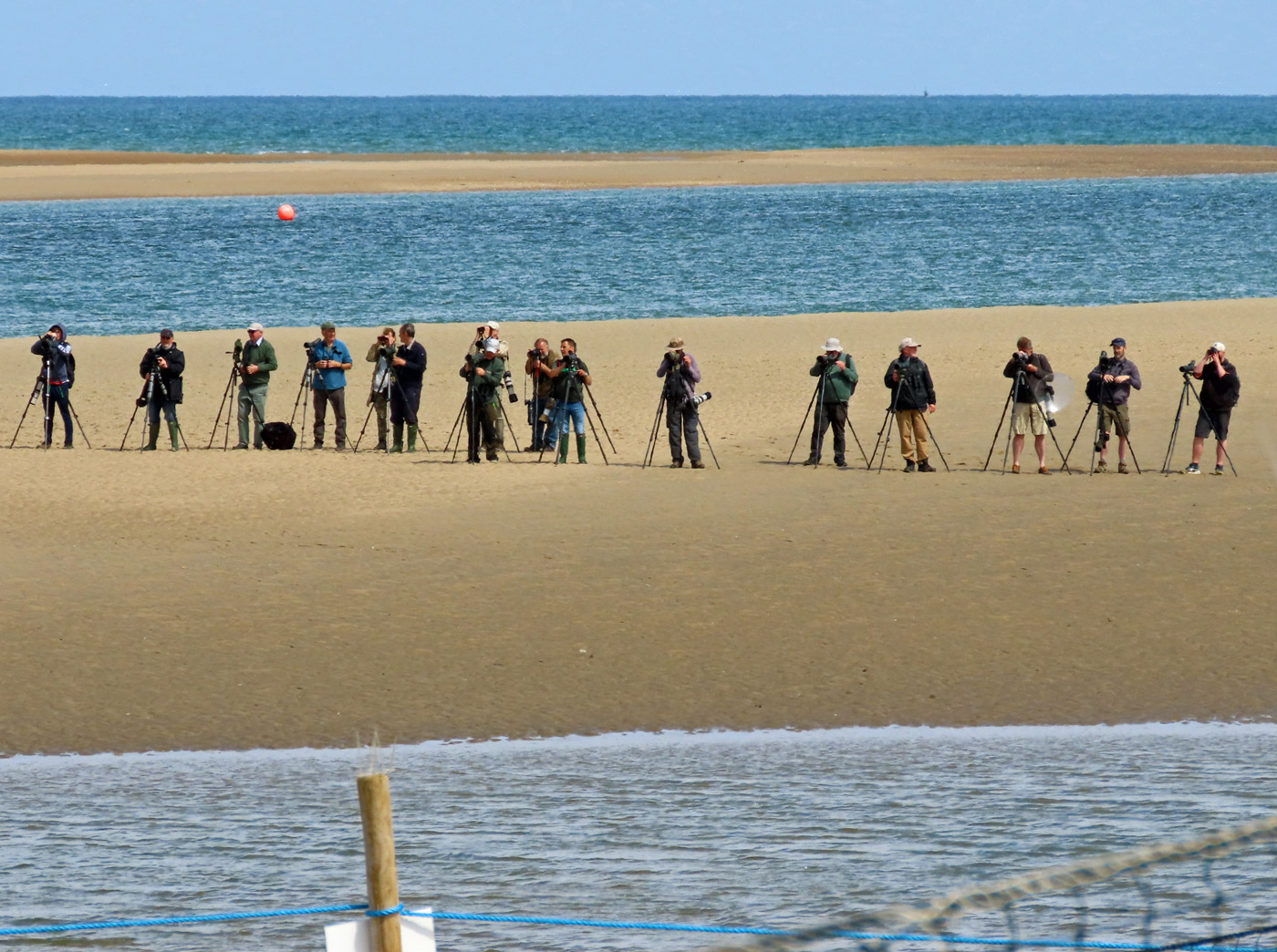
The Least Tern twitch at Portrane, Co Dublin, on 19 June 2021 (Brian Carruthers).
While we spent time delving further into the identification and behaviour of this bird, it became apparent that there was more to it than just a Little Tern with a grey rump and squeaky voice. The call was indeed 'ear-catching'. Explosive, loud and made up of several shorter phrases compared to the longer, more continuous, grating phrases of Little Tern. The squeaky pudeek-pudeek was what first made me think of Ring-necked Parakeet flight calls as an analogy. These seemed to carry further and louder over the Little Tern calls, making it easy to know when the bird was coming back from a fishing foray. The behaviour suggested it was a male, flying around carrying a fish, regularly calling and advertising to other birds – often getting harassed by Little Terns as a result. It later seemed to be paired most often with a colour-ringed Little Tern (green 'IL6', born at Kilcoole in 2018) which has a limp. Pics of IL6 (aka 'Limpy') from 2020 suggest that its partner last year was also the Least Tern, but no breeding or hybridisation has been noted yet (and each breeding pair is well monitored by the team at Portrane).
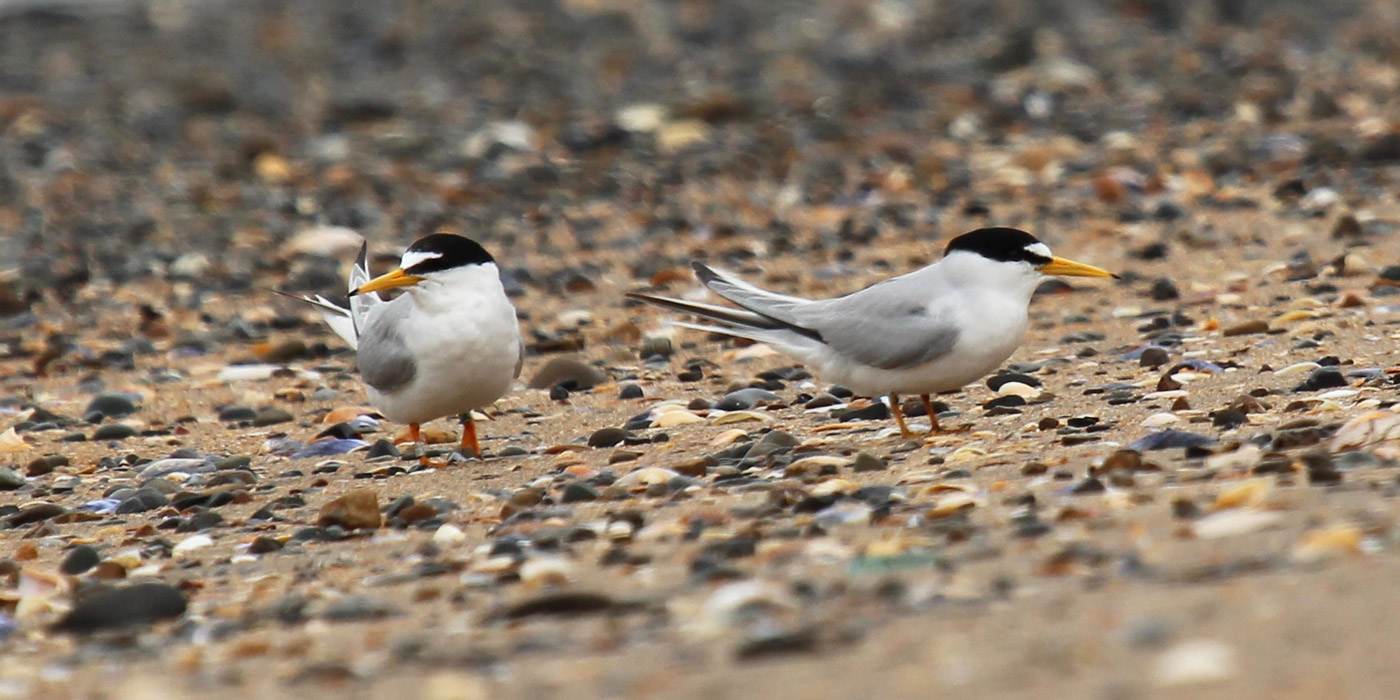
The Least Tern (right), photographed with 'Limpy', a ringed Little Tern, at the Portrane colony on 24 June 2021 (Jan Rod).
The standout plumage feature was the grey rump and tail, lacking the sharper demarcation between the white rump and grey back of Little Tern. Overall, this grey appeared to be darker than Little Tern: a 'stormy grey', reminiscent of Whiskered Tern at times (but subject to changes depending on light). In flight the side of the neck and upper breast looked to have a greyish wash, and this accentuated the white on the throat and forehead. The grey on the rump and tail was a continuation of the colour on the back, reaching down to the tip of the central tail, onto the inner tail feathers (which looked dusky or grey centred) and the grey was uniform, edge to edge across the rump and tail base. Only the outer tail feathers appeared to be white and this contrast was apparent at a distance. When at rest or in active flight with the tail closed, the outer tail feathers appeared to be longer than the Little Terns around it, tapered and slightly wavier.
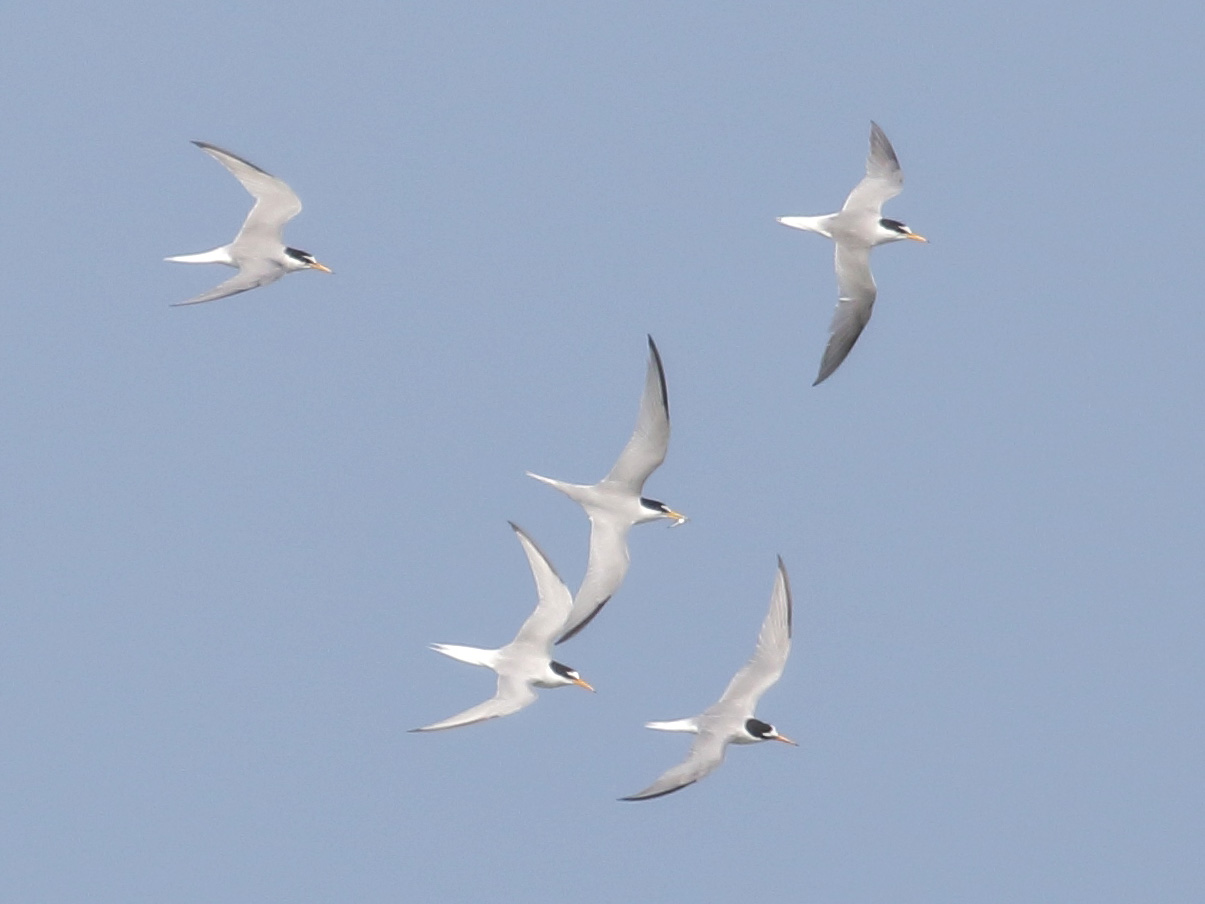
Least Tern (centre bird) with four Little Terns at Portrane, Co Dublin, June 2021 (Paul Kelly).
The bird was not as obvious when at rest. When side on, the grey rump and uppertail could be seen as a wash contrasting with the whiter longest tail feathers. The distance between the longest tail feathers and the tip of the primaries on the folded wing was shorter than on many of the Little Terns seen at rest standing beside it. The white patch on the forehead was limited in size, a feature shared by male Little Terns compared to females. This reached back to only just in front of the eye. The bill appeared broader based at times and the colour lacked the deeper orange hues of some of the Little Terns seen alongside it, feeling a flatter yellow.
The black tip to the bill was limited in its extent. Like the bill, the legs were less vibrant compared to Little Terns nearby and more yellow-brown than orange. The two outermost primaries were dark and solid looking grey-black, compared to the variable two to three dark primaries of Little Tern which can vary in colour and look more diffuse at times. When flying away it sometimes looked as if the trailing edge of the secondaries on the Least was neater and sharper, looking like a white trim. This was probably accentuated by the darker grey colour on the wing surrounding the trailing edge and the more even grey of the inner primaries. There was some debate on size and whether it did look smaller than Little Terns or not. It did indeed seem like a more compact bird at times in flight but perhaps the darker nature of the plumage could account for this.
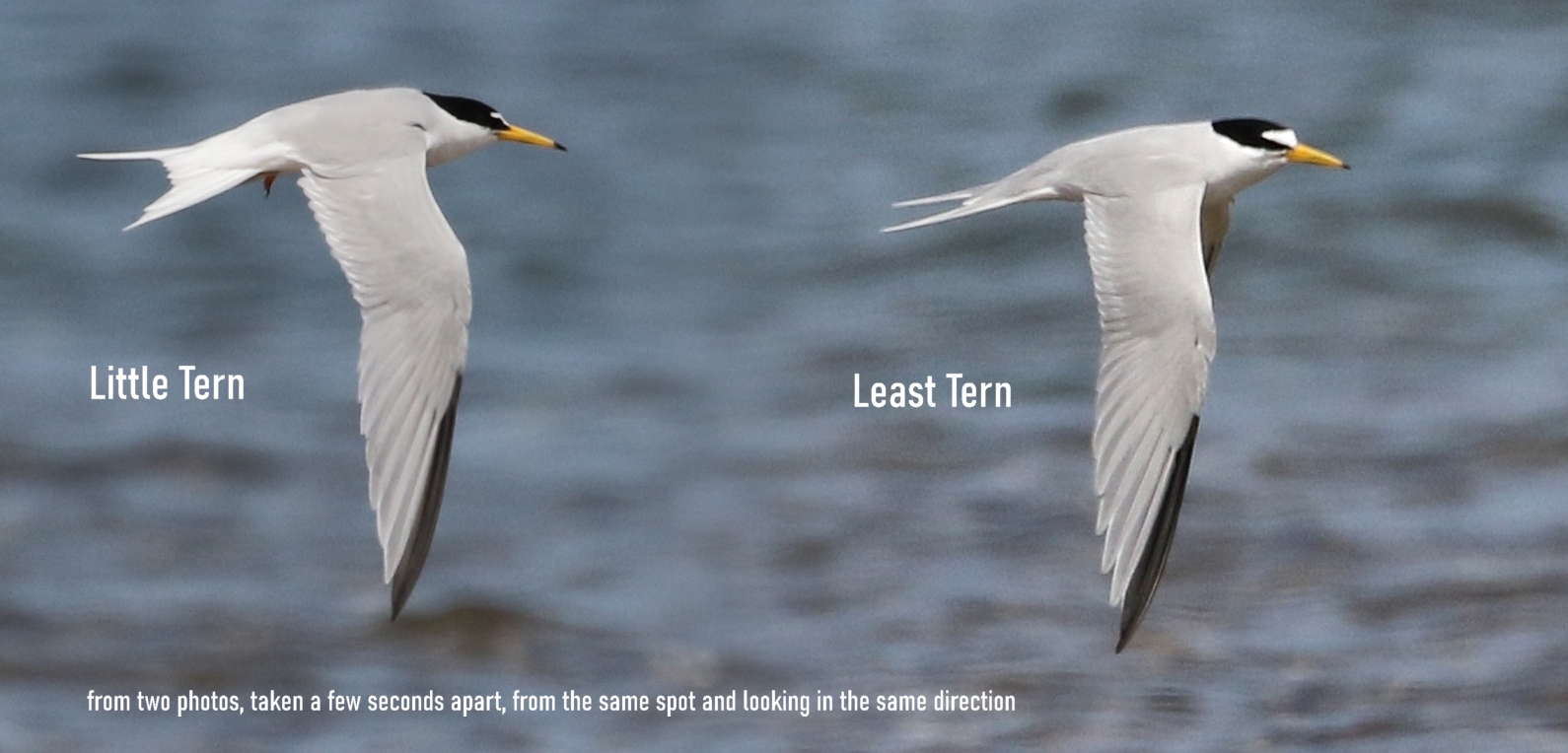
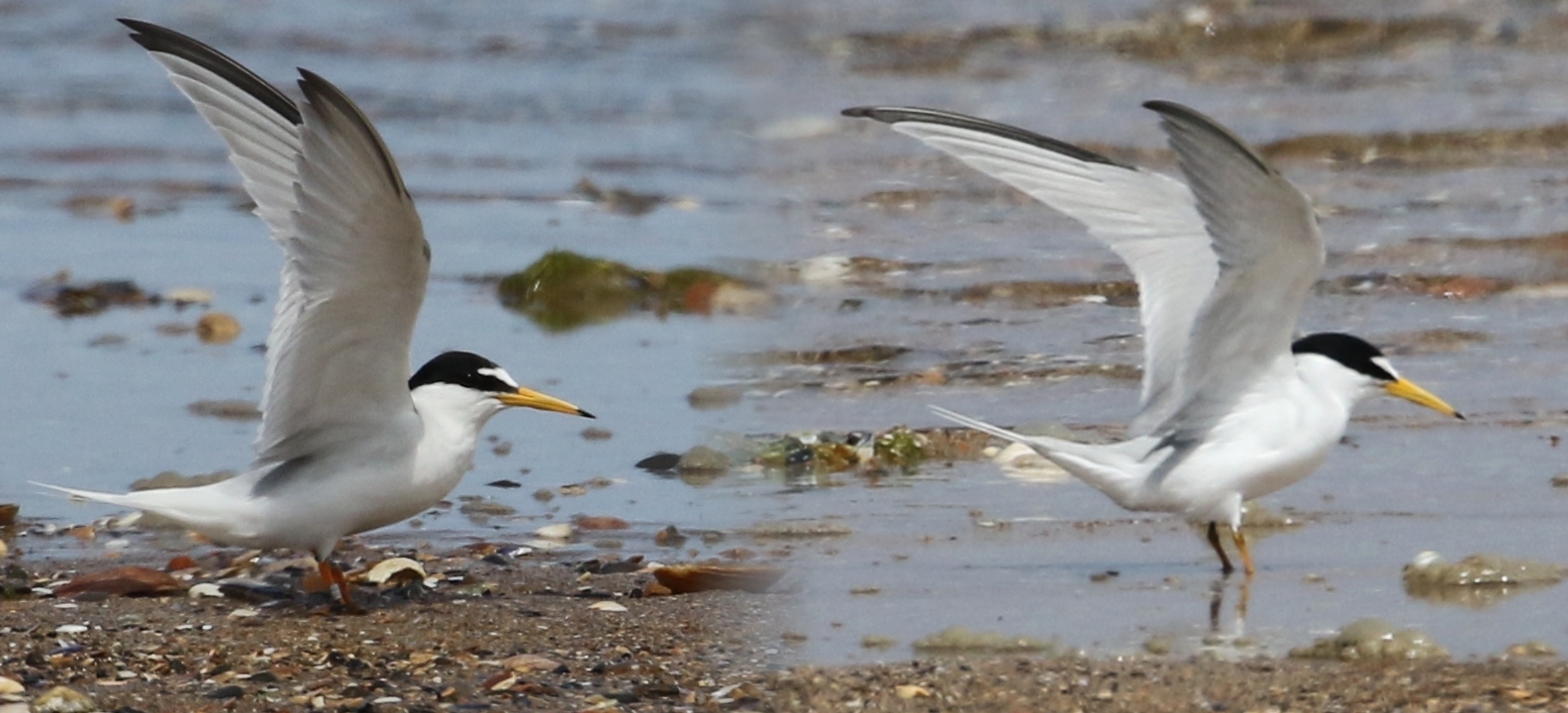
Comparisons of the Least Tern (right) with a Little Tern, Portrane, June 2021 (Killian Mullarney).
While some of the features described here are less nailed on or diagnostic and even overlap with Little Tern, the combination of them together on the same bird all add up as a supporting cast of plumage characteristics that make for quite a distinctive bird. Once we got the eye in on this bird it was surprising at how striking it looked in flight, even at a distance with binoculars.
The bird continued to be seen at Portrane almost daily, although was confirmed as visiting the Little Tern colony at Baltray, Co Louth – 26 km north of Portrane – by warden Ger Murray on 21 July, again in the company of 'Limpy'. It then moved back and forth between Baltray and Portane on subsequent dates, including 25 July when it was seen at each site 52 minutes apart. It lingered at Portrane well into August, last being noted on 24th.
This suggests that the complex post-breeding, late summer movement of terns between sites in the Irish Sea area was underway. Colour ringing of Little Terns at breeding colonies around Britain and Ireland has shown that movement of birds between sites is regular, particularly in the Irish Sea. As an example, fledglings from the Kilcoole colony regularly show up at Gronant in North Wales and the Dee Estuary area during the initial stages of migration. One particular colour-ringed juvenile from Kilcoole flew across the Irish Sea to Gronant and then back over to Portrane in a short space of time, while others were re-sighted at Dawlish Warren, Devon, and Hayling Island, Hampshire. If this is anything to go by, then birders at sites where good numbers of Little Terns can be found in the Irish Sea and south coast of England during September should be on the lookout for the Least Tern and see if they can catch it on autumn migration. As for those of us in Dublin, we look forward to its return in 2022!
Acknowledgements
Thanks to Noel Keogh and Killian Mullarney for their help with the identification of this bird on the day and to the various people who took such great pics and obtained sound recordings (some of which are used here). A huge shoutout to Tom Kavanagh, Paul Lynch and the rest of the Portrane Little Tern warden team for their tireless efforts keeping this colony safe and for their patience and kindness, showing visiting birders about who arrived to see the Least Tern.
References
Olsen K M, and Larsson H. 1995. Terns of Europe and North America. Princeton, NJ: Princeton Univ. Press.
Wilson L, Rendell-Read S, Brown C, Candelin G, Cook H, Hales S, Lock L, Newton S, Norman D, Samson L, Slattery J, Williams L, and Bolton M. 2021. Insights from colour-ringing Little Terns across Britain, Ireland and the Isle of Man. British Birds 114: 97-116.
Yates B. 2010. Least Tern in East Sussex: new to Britain and the Western Palearctic. British Birds 103: 339-347.


